GALLUP NEWS SERVICE
PRINCETON, NJ -- Three new CNN/USA Today/Gallup showdown state polls indicate President George W. Bush holds a solid lead over Sen. John Kerry in Florida, Bush holds a slim lead in Iowa, and Kerry holds a slim, but not statistically significant lead in Pennsylvania. This is the state of the race among likely voters in separate polls conducted between Oct. 21 and Oct 26.
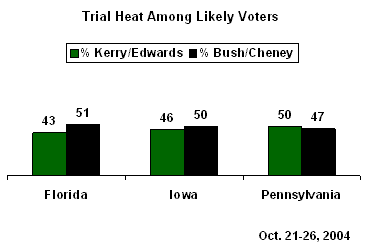
The likely voter figures represent Gallup's best estimate of how the race would turn out in these states if the election were held today. Among the broader group of all registered voters polled for each survey, Bush still leads handily in Florida but loses his edge in Iowa where the race is a statistical dead heat. Kerry maintains his three-point edge among the larger pool of registered voters in Pennsylvania.
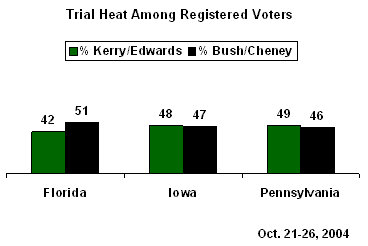
Florida
The Oct. 21-24 Florida poll shows Bush leading Kerry by 51% to 43% among likely voters. Third-party candidate Ralph Nader garners 1%, leaving 5% undecided.
This is consistent with Gallup's polling in that state in late September, when Bush led Kerry by nine points (compared with an eight-point lead today). In fact, throughout Gallup's showdown state polling in Florida, conducted since mid-July, Bush has consistently held the numerical (if not always the statistically significant) lead among likely voters.
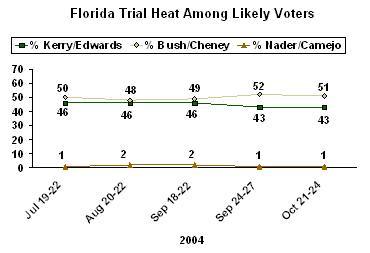
Seventeen percent of registered voters in Florida tell Gallup they have already voted in the 2004 presidential election -- either by absentee ballot or through other early voting opportunities. These early voters make up nearly a quarter of the likely voter subsample in the survey. Kerry and Bush are tightly matched among this group: 46% of early voters say they cast their ballots for Kerry, only 44% for Bush. By contrast, Bush has a strong lead -- 54% to 41% -- among those who have yet to vote.
Iowa
Al Gore won Iowa in 2000 by a razor-thin margin over Bush. Today, Gallup finds Bush holding a slim lead over Kerry, 50% vs. 46%, with Nader getting 1%. This is similar to a mid-September CNN/USA Today/Gallup poll in which Bush held a six-point lead in Iowa. Prior to that (just before the Republican convention in New York in late August), Kerry led Bush in Iowa by six points.
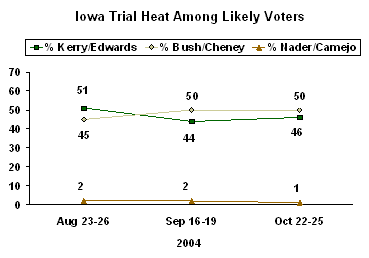
Pennsylvania
Bush and Kerry are locked in a tight race in Pennsylvania, as they have been since late August. Today, 50% support Kerry and 47% support Bush, leaving 3% undecided. Nader was denied ballot access in Pennsylvania late last week.
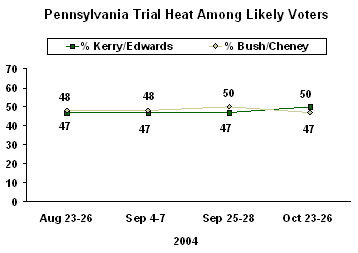
Survey Methods
FLORIDA
Results are based on telephone interviews with 909 registered voters in Florida, aged 18 and older, conducted Oct. 21-24, 2004. For results based on this sample, one can say with 95% confidence that the margin of sampling error is ±4 percentage points.
Results for likely voters in Florida are based on the subsample of 768 survey respondents deemed most likely to vote in the November 2004 presidential election, according to a series of questions measuring current voting intentions and past voting behavior. For results based on the total sample of likely voters, one can say with 95% confidence that the maximum margin of sampling error is ±4 percentage points. Based on past voting history in Florida and the current level of interest in the election, turnout is assumed to be 60% of the voting age population.
Approximately 4% of all interviews were conducted in Spanish.
In addition to sampling error, question wording and practical difficulties in conducting surveys can introduce error or bias into the findings of public opinion polls.
IOWA
Results are based on telephone interviews with 785 registered voters in Iowa, aged 18 and older, conducted Oct. 22-25, 2004. For results based on this sample, one can say with 95% confidence that the margin of sampling error is ±4 percentage points.
Results for likely voters in Iowa are based on the subsample of 649 survey respondents deemed most likely to vote in the November 2004 presidential election, according to a series of questions measuring current voting intentions and past voting behavior. For results based on the total sample of likely voters, one can say with 95% confidence that the maximum margin of sampling error is ±5 percentage points. Based on past voting history in Iowa and the current level of interest in the election, turnout is assumed to be 65% of the voting age population.
In addition to sampling error, question wording and practical difficulties in conducting surveys can introduce error or bias into the findings of public opinion polls.
PENNSYLVANIA
Results are based on telephone interviews with 807 registered voters in Pennsylvania, aged 18 and older, conducted Oct. 23-26, 2004. For results based on this sample, one can say with 95% confidence that the margin of sampling error is ±4 percentage points.
Results for likely voters in Pennsylvania are based on the subsample of 670 survey respondents deemed most likely to vote in the November 2004 presidential election, according to a series of questions measuring current voting intentions and past voting behavior. For results based on the total sample of likely voters, one can say with 95% confidence that the maximum margin of sampling error is ±4 percentage points. Based on past voting history in Pennsylvania and the current level of interest in the election, turnout is assumed to be 60% of the voting age population.
In addition to sampling error, question wording and practical difficulties in conducting surveys can introduce error or bias into the findings of public opinion polls.
FLORIDA
4. (Asked of those who have not already voted) Now, suppose that the presidential election were being held today, and it included John Kerry and John Edwards as the Democratic candidates, George W. Bush and Dick Cheney as the Republican candidates, and Ralph Nader and Peter Camejo as independent candidates. Would you vote for – [ROTATED: Kerry and Edwards, the Democrats, Bush and Cheney, the Republicans, (or) Nader and Camejo, the independent candidates]?
4A. As of today, do you lean more toward – [ROTATED: Kerry and Edwards, the Democrats, Bush and Cheney, the Republicans (or) Nader and Camejo, the independents]?
4-1. (Asked of those who already voted) Who did you vote for in the presidential election? [OPEN-ENDED]
|
|
Kerry/ |
Bush/ |
Nader/ |
Neither/other/ |
|
|
% |
% |
% |
% |
|
Likely voters |
|
|
|
|
|
2004 Oct 21-24 |
43 |
51 |
1 |
5 |
|
2004 Sep 24-27 |
43 |
52 |
1 |
4 |
|
2004 Sep 18-22 |
46 |
49 |
2 |
3 |
|
2004 Aug 20-22 |
46 |
48 |
2 |
4 |
|
2004 Jul 19-22 |
46 |
50 |
1 |
3 |
|
|
|
|
|
|
|
Registered voters |
|
|
|
|
|
2004 Oct 21-24 |
42 |
51 |
1 |
6 |
|
2004 Sep 24-27 |
44 |
49 |
2 |
5 |
|
2004 Sep 18-22 |
45 |
47 |
2 |
6 |
|
2004 Aug 20-22 |
45 |
45 |
3 |
7 |
|
2004 Jul 19-22 |
44 |
49 |
2 |
5 |
IOWA
4. Now, suppose that the presidential election were being held today, and it included John Kerry and John Edwards as the Democratic candidates, George W. Bush and Dick Cheney as the Republican candidates, and Ralph Nader and Peter Camejo as independent candidates. Would you vote for – [ROTATED: Kerry and Edwards, the Democrats, Bush and Cheney, the Republicans, (or) Nader and Camejo, the independent candidates]?
4A. As of today, do you lean more toward – [ROTATED: Kerry and Edwards, the Democrats, Bush and Cheney, the Republicans (or) Nader and Camejo, the independents]?
|
|
Kerry/ |
Bush/ |
Nader/ |
Neither/other/ |
|
|
% |
% |
% |
% |
|
Likely voters |
|
|
|
|
|
2004 Oct 22-25 |
46 |
50 |
1 |
3 |
|
2004 Sep 16-19 |
44 |
50 |
2 |
4 |
|
2004 Aug 23-26 |
51 |
45 |
2 |
2 |
|
|
|
|
|
|
|
Registered voters |
|
|
|
|
|
2004 Oct 22-25 |
48 |
47 |
1 |
4 |
|
2004 Sep 16-19 |
43 |
48 |
3 |
6 |
|
2004 Aug 23-26 |
50 |
44 |
2 |
4 |
PENNSYLVANIA
4. (Asked of all respondents) Now, suppose that the presidential election were being held today, and it included John Kerry and John Edwards as the Democratic candidates, George W. Bush and Dick Cheney as the Republican candidates, and Ralph Nader and Peter Camejo as independent candidates. Would you vote for – [ROTATED: Kerry and Edwards, the Democrats, Bush and Cheney, the Republicans, (or) Nader and Camejo, the independent candidates]?
4A. As of today, do you lean more toward – [ROTATED: Kerry and Edwards, the Democrats, Bush and Cheney, the Republicans (or) Nader and Camejo, the independents]?
2. (Asked of Nader voters) If Ralph Nader is not on the ballot in your state on Election Day, would you vote for – [ROTATED: Kerry and Edwards, the Democrats (or) Bush and Cheney, the Republicans]?
2A. As of today, do you lean more toward – [ROTATED: Kerry and Edwards, the Democrats (or) Bush and Cheney, the Republicans]?
NOTE: Nader voters' response from Q.2/2A substituted for Nader vote in Q.4/4A to calculate results for match-up of Bush versus Kerry. Nader was officially denied ballot access in Pennsylvania while the Oct. 23-26 poll was in the field. Results of the Bush/Kerry/Nader trial heat not reported.
|
|
Kerry/ |
Bush/ |
Neither/other/ |
|
|
|
% |
% |
% |
|
|
Likely voters |
|
|
|
|
|
2004 Oct 23-26 |
50 |
47 |
3 |
|
|
2004 Sep 25-28 ^ |
47 |
50 |
3 |
|
|
2004 Sep 4-7 |
47 |
48 |
5 |
|
|
2004 Aug 23-26 |
47 |
48 |
5 |
|
|
|
|
|
|
|
|
Registered voters |
|
|
|
|
|
2004 Oct 23-26 |
49 |
46 |
5 |
|
|
2004 Sep 25-28 ^ |
49 |
46 |
6 |
|
|
2004 Sep 4-7 |
47 |
47 |
6 |
|
|
2004 Aug 23-26 |
49 |
44 |
7 |
|
|
|
|
|
|
|
|
^ |
Asked of all respondents and asked before Kerry vs. Bush vs.
Nader question. |
|||